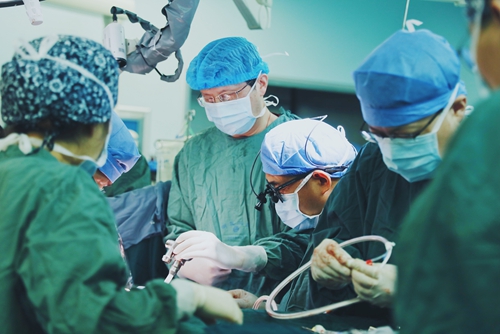Left Ventricular Assist Device (LVAD) Saves Critical Patient
The first Left Ventricular Assist Devices (LVAD) implantation of Zhejiang province is performed by the Second Affiliated Hospital,Zhejiang University School of Medicine (SAHZU) Heart Center on Feb. 28. It is also the first LVAD implantation ever done in East China.

LVAD device is especially meaningful for critically ill patients with failing heart function. It could be either used as bridge-to-transplant therapy that helps patients awaiting heart transplant survive until a donor heart becomes available, or used as destination therapy to support patients with end-stage heart failure who are not candidates for heart transplant for the rest of their life and improve their life quality, said Prof. WANG Jian'an, Head of SAHZU and Chair of SAHZU Heart Center.
The patient who underwent this procedure is Mr. MA. His chest tightness kept worsening over the past two years that, in December last year, eventually developed to a severe status where Mr. MA started to have a decreasing appetite and vomit after eating. Mr. MA was admitted into SAHZU Cardiovascular Surgery and quickly diagnosed as end-stage heart failure due to dilated cardiomyopathy.
Mr. MA's myocardium had decreased ability to pump blood, which caused his heart failure. He was in a severely critical condition, said Chair of SAHZU Cardiovascular Surgery Prof. DONG Aiqiang. A heart transplant surgery should be able to solve his problem. However, donor heart doesn't just turn up when you need it the most. The LVAD device was his last chance.
Open heart surgery is needed to implant the LVAD. During the procedure, SAHZU surgeons opened Mr. MA's chest, put him on the heart-lung bypass machine, repaired Mr. MA's mitral valve and tricuspid valve, and then place the LVAD device in patient's chest.
After hours of collaboration of SAHZU heart program, anesthesiology team and nursing team, the LVAD device started to work properly in Mr. MA's chest at 11:43 AM. Now, Mr. MA is in a stable condition.
Left Ventricular Assist Device (LVAD), the size of which is about half of fist, is made of special metal material. In the LVAD device implantation, patient's heart will not be replaced by the device. Instead, the device is implanted in patient's left ventricle to help it work, because patient's heart cannot contract normally. LVAD is a mechanical pump that receives blood from the left ventricle and delivers it to the aorta and the rest of body, bringing blood and nutrition to all body organs.
The LVAD device used by SAHZU heart program is the EVAHEART I, the third-generation of LVAD.

